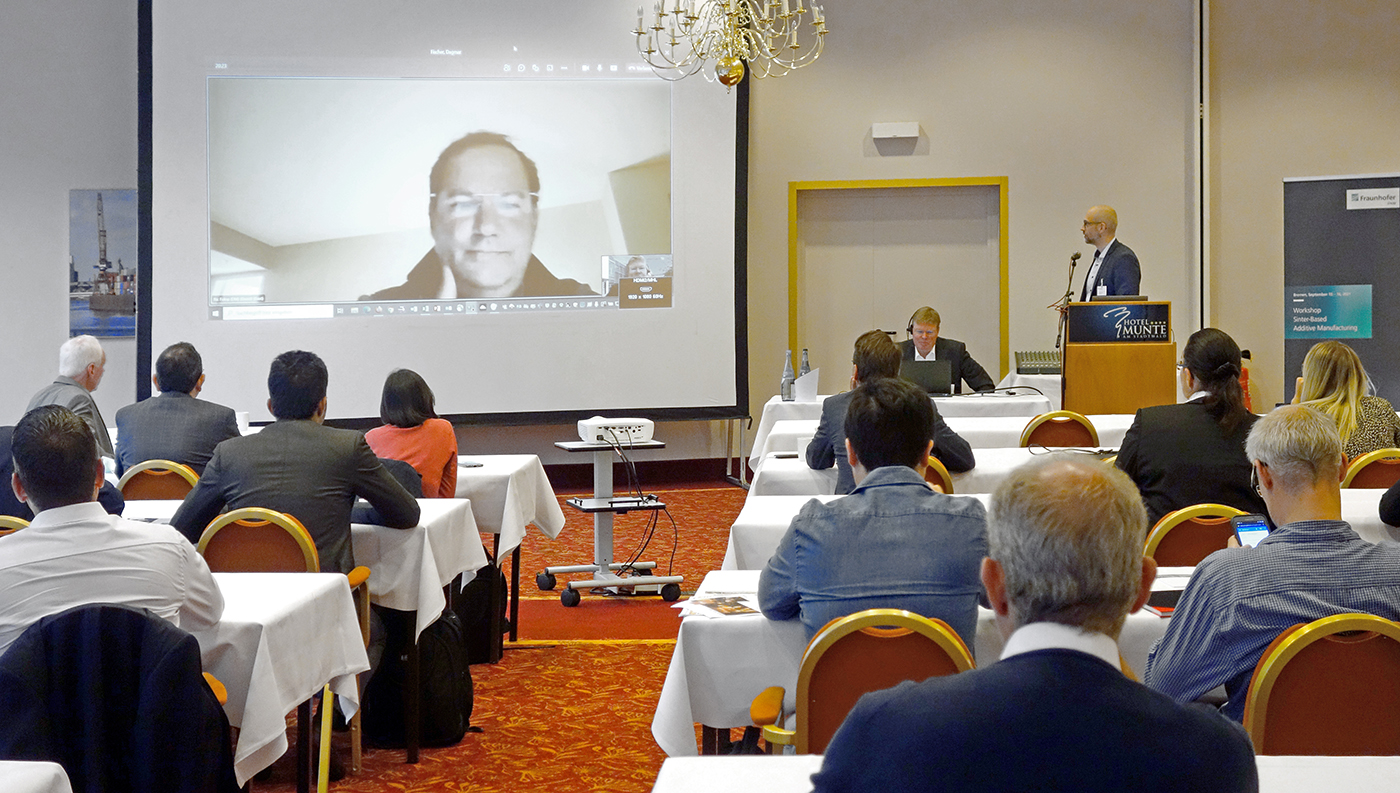Binder Jetting and beyond: Insights from Fraunhofer IFAM’s second workshop on sinter-based Additive Manufacturing
After a one-year break, seventy industry and R&D participants from twelve countries found their way to the 2nd Workshop on Sinter Based Additive Manufacturing, Bremen, Germany, held from September 15–16, 2021. Industry suppliers, part producers, end-users and researchers, as well as experts from the event organiser, Fraunhofer IFAM, considered the status of existing and new technologies in the field. Whilst metal Binder Jetting (BJT) received the most attention, Material Extrusion (MEX) technologies were also covered in depth. Prof Dr-Ing. Frank Petzoldt and Dr Sebastian Hein report. [First published in Metal AM Vol. 7 No. 4, Winter 2021 | 15 minute read | View on Issuu | Download PDF]
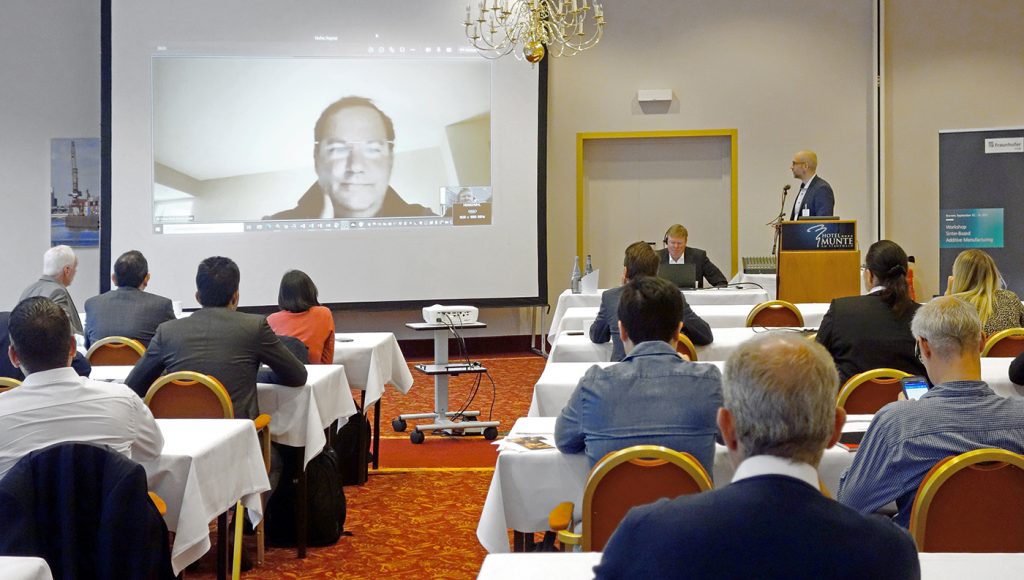
Binder Jetting: Pushing equipment, binders and powders to the next level
As the sinter-based AM technology which allows for the highest production rates for metal parts, the first day of the workshop focused fully on metal Binder Jetting (BJT). While most participants agreed that this is a maturing technology for limited series production, some, such as Desktop Metal’s CEO Ric Fulop, went so far as to say that the technology is ready for mass production.
Binder Jetting is a flexible production method that is especially well known for manufacturing prototypes and metal parts in small-scale series. However, speakers at the workshop showed its potential for mass production. Fulop joined the workshop via livestream from the USA and gave insights into his company’s Single Pass Jetting (SPJ) machines, built for high-speed production of metal parts. He also discussed new equipment from his company that will integrate the sintering process, thus making sinter-based Additive Manufacturing more accessible and easier to use for customers. These integrated technologies would indeed bring the industry a lot closer to a closed mass-production process.
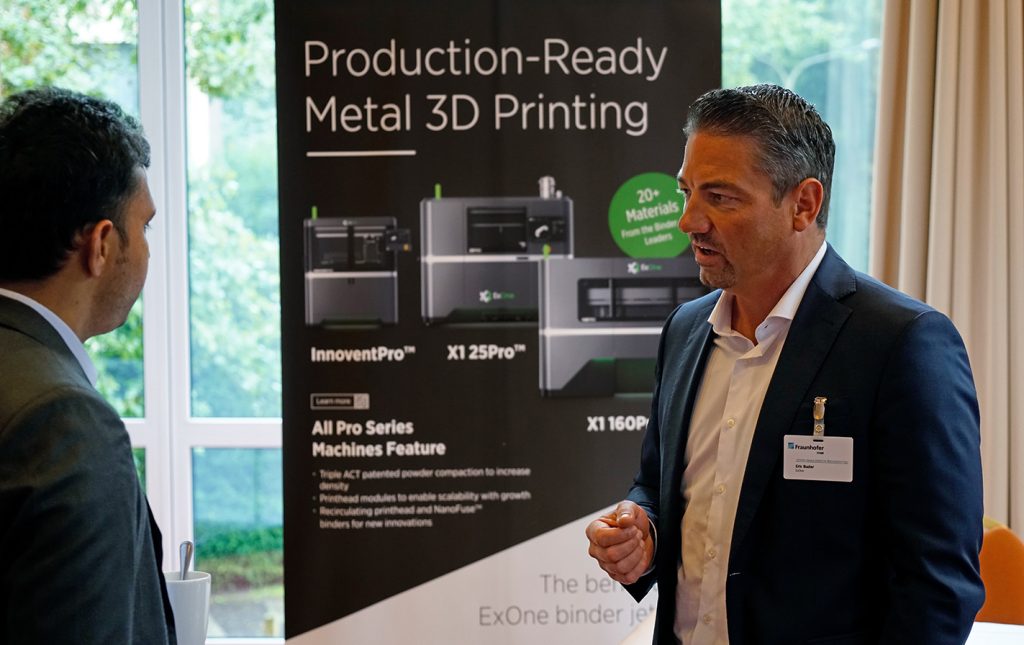
Throwing a light on current developments in new binders, Andrew Klein from The ExOne Company showed promising results for nanoparticle-based binders for working with reactive metals such as copper. By incorporating nanoparticles as sintering aids, ExOne reached an average of 2% higher green density. Currently, the company is optimising the binder and Binder Jetting system to apply them to aluminium and titanium.
Alexander Rütjes, Volkswagen AG, looked at sinter-joining possibilities for BJT parts, which is especially interesting for such companies which must consider the challenges of both depowdering of intricate parts and manufacturing large parts at scale. As one route to face these challenges, Alexander Rütjes gave insights into initial results of joining green parts by using powder interlayers in the sintering process, thereby allowing Volkswagen to exploit sintering as a joining process on a microscopic level.
When it needs to be tough and hard: Sinter-based AM also possible for cutting tools
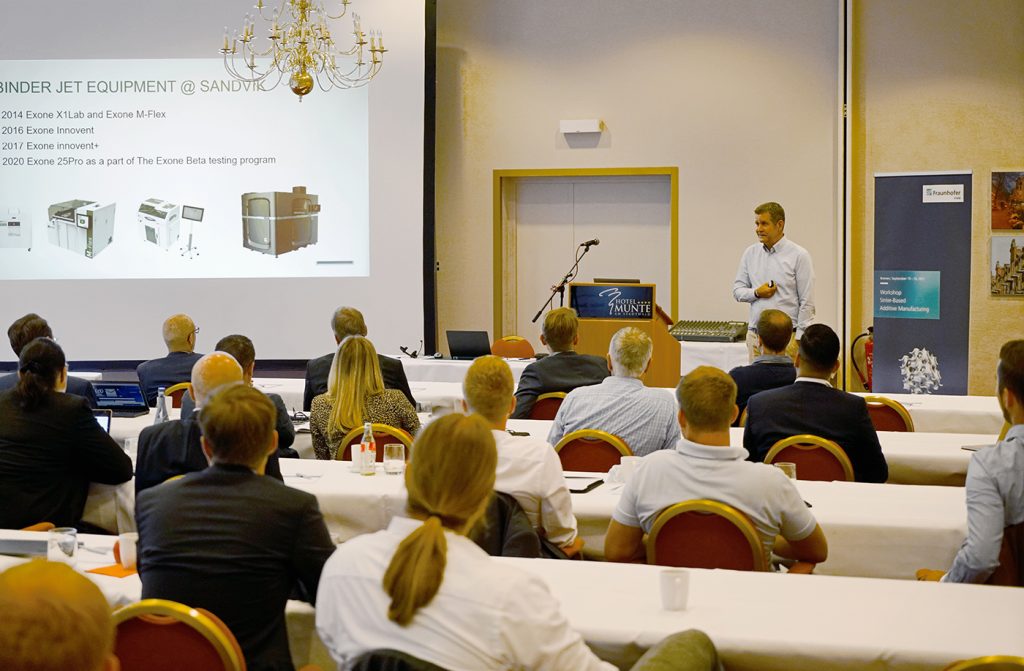
Two speakers presented Binder Jetting case studies for the production of cutting tools and argued that sinter-based AM is especially suitable. Iñigo Agote, Tecnalia, Spain, explained that conventional manufacturing methods considerably limit the possible shapes of cutting tools and are only profitable above a certain number of produced tools in order to amortise the cost of the dies. Moreover, lead times for new developments are very long. In areas like design flexibility and prototyping, AM offers considerable advantages – and, since AM usually also entails fewer steps than conventional methods, it is worthwhile to explore AM. But which AM method to choose?
As Powder Bed Fusion (PBF) AM processes, in particular Laser Beam Powder Bed Fusion (PBF-LB), work with high-energy sources that melt the materials and creates very high cooling and heating rates, typical materials for cutting tools (e.g., WC-Co, M2, H13, ceramics and cermets) do not withstand such thermal shocks, which lead to cracks in the material. Moreover, the obtained density of the parts is often too low for tooling applications. In contrast, sinter-based AM processes do not use heat sources to consolidate the material. According to Agote, it is basically a die-less manufacturing process, which uses conventional post-processing to finish the part. Binder Jetting, then, compared to other AM methods, brings the known advantages of good surface quality, high resolution, a high production rate and a considerable cost reduction.
While Agote showed that Tecnalia achieved good mechanical properties with WC-Co by using Binder Jetting, Mikael Schuisky from Sandvik Additive Manufacturing, Sweden, discussed in depth the available metal powders and their properties for manufacturing cemented carbide tools. Both speakers showed the capabilities of Binder Jetting for the production of metal parts that need to be both extremely tough and hard. Though the costs for Binder Jetting of a cemented carbide component is, according to Schuisky, still 2-5 times that of conventional manufacturing today, he is confident that sinter-based AM has the potential of getting into the same range in the near future.
Know your powder: Powder properties and part quality for Binder Jetting
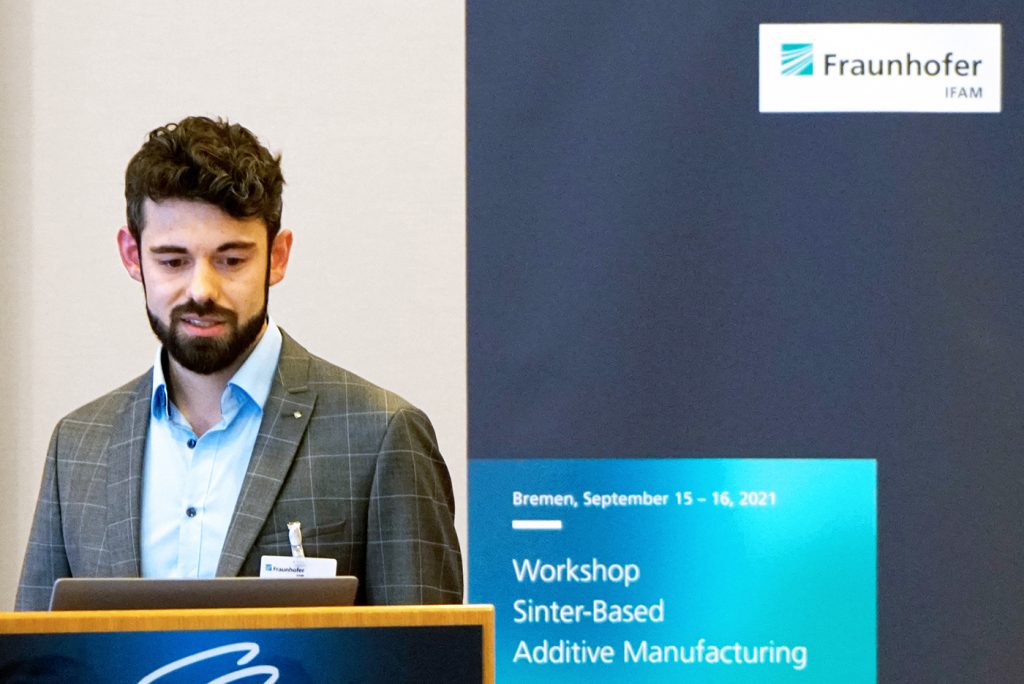
Three speakers shed light on metal powders, their properties and how they can contribute to part quality. Ralf Carlström introduced a new fine metal powder from his company, Höganäs AB, Sweden, for use in Binder Jetting, which is more cost-effective while offering high-quality properties. Metal powders for AM are typically produced by gas atomisation technology. Since 2015, however, Höganäs has been working intensively on the development and refinement of water atomised fine powders. In April 2021, the company opened a new fine powder plant in Johnstown, Pennsylvania, USA, where this technology is implemented on a larger scale.
Water atomisation has the benefit of having higher scalability for the powder producer, thus reducing costs, from which the powder buyer, in turn, also profits. Water atomised powders have slightly different morphological and chemical characteristics than gas atomised powders, though. Carlström shared experiences from using water atomised fine 316L powder for Binder Jetting. Among other things, the results showed a sintered density of over 98% and a higher density area close to the part surface. The latter has positive effects for the surface finish, corrosion protection and mechanical properties.
Alexander Elsen from Heraeus Group, Germany, provided a deep dive into the capabilities of powder production focused for AM processes. Several powder properties were demonstrated, as well as their relation to the powder’s flowability. He stressed the importance of a robust process in order to keep the specifications simple, which is usually not the case in AM today.
Bastian Barthel is a researcher at Fraunhofer IFAM, whose work looks at the relation of powder particle properties to parameters in the manufacturing, curing and sintering processes. At the workshop, he presented some of his findings. For instance, using metal powders like 316L, A11 and Nikro 128, with various layer thicknesses, Barthel ran separate build processes at two different roller traverse speeds (5 mm/s and 20 mm/s). Subsequently, he looked at the density of the green part. He discovered that a lower layer thickness significantly improves green part density. The traverse speed, though, is dependent on the powder’s flowability – here, particle shapes come into play. For instance, spherical powders show superior flowability and packing behaviour and, thus, can be processed faster. Irregularly shaped powders, on the other hand, achieve better results from lower roller traverse speeds. In short, he showed that particle shape and particle size distribution have a major impact on processing behaviour. For manufacturers, this means that powder quality management is crucial for building mass production processes with Binder Jetting.
Automation and simulation: New approaches for better results
On the way to becoming a method for mass production, Additive Manufacturing technologies like Binder Jetting still have several hurdles to overcome. In his presentation, Andreas Hartmann from Solukon considered the depowdering step, often done manually. Manual depowdering, however, can cause considerable time loss, danger and quality defects, as Hartmann pointed out; his company has developed an automated solution. The automation of this process step supports time savings, safe and complete powder recovery as well as reproducible cleaning results, thus enabling better quality management. This can be a key factor for Additive Manufacturing technologies to meet the requirements for mass production. Automating this step allows for integration into a fully digitally controlled process. Hartmann showed how an automated depowdering process can be optimised for each part geometry using intelligently controlled endless axis rotation. Current developments for the handling of plastic parts achieve unpacking and cleaning within sixty minutes – something which metal AM should hope to achieve as soon as possible.
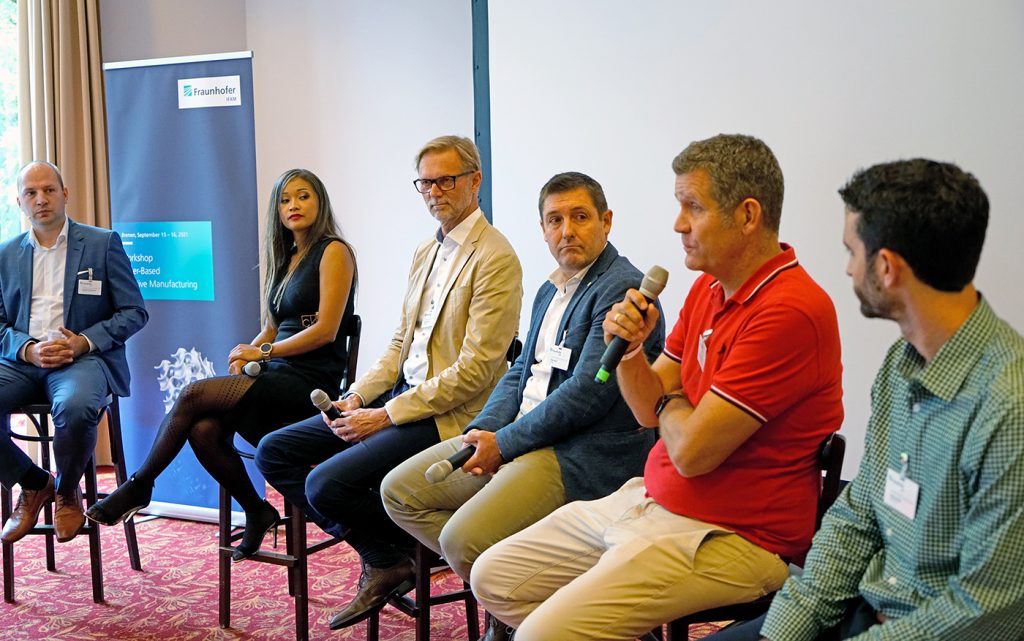
Another aspect in need of better understanding and control is shrinkage during sintering. Dr Kiranmayi Abburi Venkata, Simufact Engineering, Germany, pointed out that sintering usually densifies the part from 60% to 95%, 35% of which is nonlinear shrinkage. In order to achieve a better grip on the sintering results, a simulation of the process is practically mandatory. All manufacturers know that large shrinkage requires compensation, as creep effects during sintering can be catastrophic. Yet, as Abburi Venkata highlighted, material data available in the literature are insufficient for use in existing simulation models. Simufact Engineering has developed a simulation software that implements several important functionalities, such as the prediction of densification and distortion under friction and gravity. Further enhancements are planned to be incorporated, but promising results were shown with the already existing tools.
Of great importance to understanding the sintering process is the thermal balance in the furnace. Götz Hartmann, Magma GmbH, addressed the challenge that furnace temperatures are non-uniform and transient. Moreover, there is practically no reliable – and certainly no real-time – thermic and thermomechanical data of powders during sintering. At the same time, parts undergo three- dimensional stress and strain due to creeping that we want to control. One approach to understanding and optimising this process is by using process simulations. Hartmann showed Magma’s fast way to generate furnace CAD models as a basis for thermal and gas flow simulation. The potential to combine this approach with further simulation tools may represent a way to a practical sinter simulation for specific machinery.
New technologies and materials for other sinter-based AM
Material Extrusion (MEX)
Though Binder Jetting was the most discussed AM technology at the workshop, other technologies and processes were also presented. A very promising new technology comes from Spain’s Triditive, called Additive Multimaterial Deposition (AMD). This MEX-based technology can process filaments based on metals, composites and polymers simultaneously. Mariel Diaz, CEO and founder Triditive, focused on the production of metal parts in her presentation and showed how Triditive can optimise process parameters in order to achieve the best results for high-density parts.

Another MEX-based AM technology that can also process up to three materials, was presented by Vincent Morrison from Germany’s AIM3D. This young company started as a spin-off from the University of Rostock, Germany, and has developed what it calls Composite Extrusion Modelling (CEM). This uses well-known thermoplastic injection moulding materials, but in standard feedstock pellets rather than filament. Compared to MIM, CEM requires fewer steps in the production chain, resulting in faster lead times. Morrison presented an impressive use case in which the company significantly reduced the usual MIM lead times of eight-to-twelve weeks to one-to-three days using CEM.
Firat Hizal, Head of Metal Systems at BASF, Germany, reported on new filaments from his company that will make complex designs manufacturable via Fused Filament Fabrication (FFF). Support filaments for the commercially available Ultrafuse 316L and 17-4 PH stainless steels will soon be on the market. Further filaments based on titanium and nickel alloys are currently under development.
The Danish company AddiFab tested several MIM feedstocks, such as BASF’s Catamold 8620, to see if they could shorten lead time using its Freeform Injection Moulding (FIM) technology. CEO Lasse Guldborg Staal was a presenter at the workshop and reported that the first green bodies were ready for debinding and sintering forty-eight hours after receiving the first batch of granulate feedstock. First analyses of the parts show important similarities to MIM parts. AddiFab is currently looking for project partners to explore the possibilities of this technology and new material combinations.
Vat Photopolymerisation (VPP)
Thomas Studnitzky and Robert Teuber from Fraunhofer IFAM introduced two novel sinter-based approaches in AM that process paste-based feedstock. Recently, the institute has expanded its equipment to explore new AM technologies and material systems. Studnitzky started with Lithography-based Metal Manufacturing (LMM) also known as Vat Photopolymerisation. Feedstock is a paste containing metal powder combined with a photosensitive organic binder system. It stays in the solid state at room temperature, but liquidises at approximately 50°C. At the beginning of the process, a heat blade liquefies the paste in a reservoir and then distributes it onto the build platform. Subsequently, selective curing by near UV-light (405 nm) takes place to cure the desired geometry, layer by layer. When the process is complete, a solid block containing cured and non-cured feedstock is moved from the build chamber. Non-cured feedstock is then removed by melting, and the resulting part can be debound and sintered. Studnitzky sees many advantages for this process – for instance, there are nearly no design restrictions and no cost-intensive operator time is required for demoulding or the removal of support structures.
MoldJet
Robert Teuber presented the MoldJet process from Tritone, Israel. This is a paste processing AM technology that opens up new possibilities in the design freedom of metal components and offers enormous productivity. It combines two manufacturing processes for the flexible production of customer-specific parts. These work alternately with layered component production. First, the mould is produced in one layer as a negative of the component geometry from a wax-like polymer via inkjetting heads. This layer of mould material is then filled with metal powder paste via a slotted nozzle and a ‘squeegee.’ Due to the layer-by-layer design, the production of complex components with undercuts or even internal channels is possible without the use of support structures. By arranging several components next to each other, a whole batch of parts can be produced in one build. In addition, several batches can be placed on top of each other.
Conclusion
The second Fraunhofer IFAM workshop on sinter-based AM offered participants a thorough overview of current developments in the field, highlighting a technology which is, in some cases approaching technological maturity, and which is making encouraging progress toward readiness for mass production. It is clear from the presentations given during the seminar that the sinter-based AM processes currently available on the market offer considerable benefits for a range of applications, with further opportunities coming into reach with process optimisation.
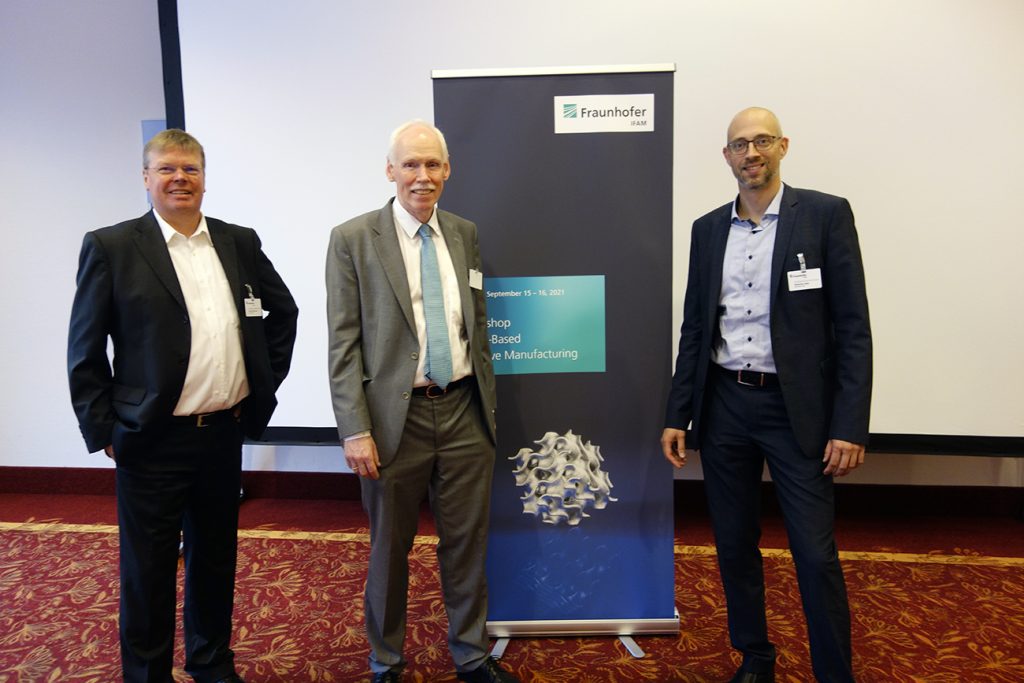
After a long period without live events, all participants were eager to discuss these promising topics in the flesh once more, and are sure to have returned home with inspiration for their own projects. We look forward to seeing the further developments on offer at the next workshop.
Authors
Prof Dr-Ing. Frank Petzoldt and Dr Sebastian Hein
Fraunhofer Institute for Manufacturing Technology and Advanced Materials IFAM
Wiener Strasse 12
28359 Bremen
Germany





